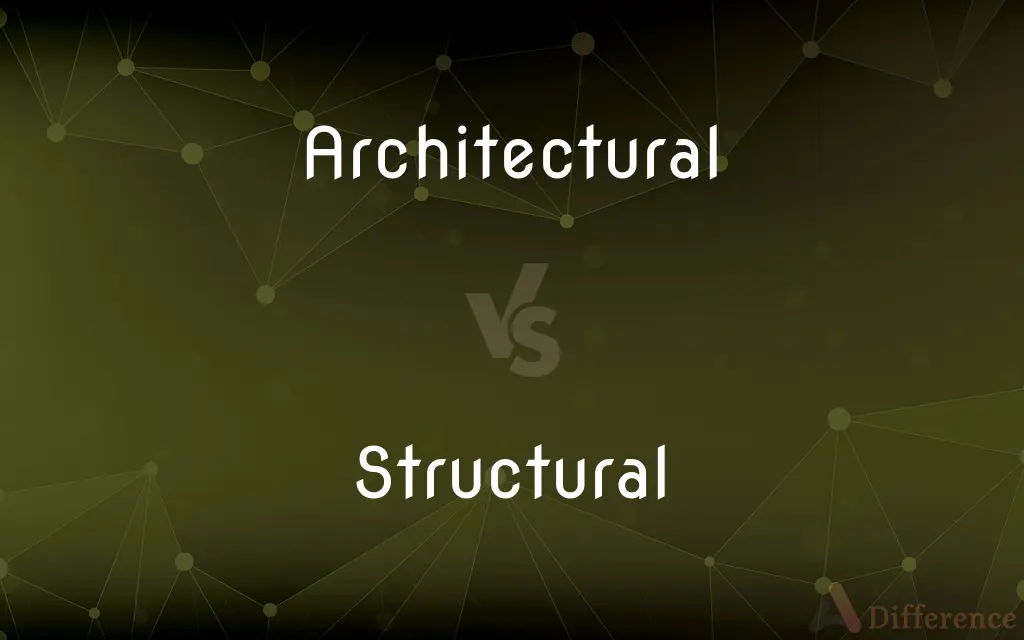Architectural vs. Structural — What's the Difference?
By Tayyaba Rehman & Fiza Rafique — Updated on April 15, 2024
Architectural design focuses on the aesthetics and functionality of buildings, emphasizing space layout and facade, while structural engineering ensures stability and safety through support systems and materials.

Difference Between Architectural and Structural
Table of Contents
ADVERTISEMENT
Key Differences
Architectural design prioritizes the aesthetic appeal and functional layout of buildings, aiming to create visually pleasing and practical spaces. On the other hand, structural engineering is primarily concerned with the strength, durability, and safety of the building, focusing on the framework and support.
Architects design the building's look and feel, considering factors like lighting, materials, and space usage to enhance human interaction. Structural engineers, whereas, ensure that these designs are feasible and will stand up under environmental stresses and usage demands.
Architectural projects often begin with conceptualizing the space's visual and practical aspects, such as the flow between rooms and the overall theme of the design. Conversely, structural engineers work on calculating load capacities, choosing appropriate building materials, and designing structures that safely support the building.
In architectural design, creativity and innovation play significant roles, allowing architects to experiment with new forms and materials. On the other hand, structural engineering requires a rigorous adherence to safety standards and mathematical precision to prevent structural failures.
Architects often use software like AutoCAD or SketchUp to create renderings and visualizations of the proposed designs, providing a clear picture of the finished product. Structural engineers utilize different tools, such as SAP2000 or STAAD.Pro, to model stress responses and ensure the building’s structural integrity.
ADVERTISEMENT
Comparison Chart
Focus
Aesthetics, functionality
Safety, durability
Main Concerns
Space usage, design appeal
Load capacity, material strength
Tools Used
AutoCAD, SketchUp
SAP2000, STAAD.Pro
Role in Construction
Designing user experience
Ensuring structural soundness
Outcome Importance
Enhances human interaction
Prevents structural failure
Compare with Definitions
Architectural
Aims to integrate environmental elements into building design.
Architectural designs often include features like green roofs.
Structural
Concerned with the engineering behind building structures.
Structural analysis ensures the skyscraper can withstand earthquakes.
Architectural
Relating to the arrangement of physical spaces.
Architectural considerations determine how spaces influence user interactions.
Structural
Focuses on the strength and stability of constructions.
Structural reinforcements were added to support the increased load.
Architectural
Involves the selection of design materials and colors.
Architectural trends favor sustainability and natural materials.
Structural
Ensures compliance with safety codes and regulations.
Structural engineers must adhere to strict building codes.
Architectural
Focuses on the visual impact of structures.
Architectural brilliance is evident in the building's innovative facade.
Structural
Involves the use of technical calculations and simulations.
Structural integrity is verified through advanced computer modeling.
Architectural
Pertaining to the art and science of designing buildings and structures.
The architectural plan outlines the layout and facade aesthetics.
Structural
Relates to the materials used to construct the building framework.
Structural steel is preferred for its strength and flexibility.
Architectural
The art and science of designing and erecting buildings.
Structural
Of, relating to, having, or characterized by structure
Structural simplicity.
Architectural
Buildings and other large structures
The low, brick-and-adobe architecture of the Southwest.
Structural
Affecting structure
Structural damage.
Architectural
A style and method of design and construction
Byzantine architecture.
Structural
Used in or necessary to building
Structural beams.
Architectural
Orderly arrangement of parts; structure
The architecture of the federal bureaucracy.
The architecture of a novel.
Structural
Concerned with or resulting from political or especially economic structure.
Architectural
(Computers) The overall design or structure of a computer system or microprocessor, including the hardware or software required to run it.
Structural
(Geology) Of or relating to the structure of rocks and other aspects of the earth's crust.
Architectural
Any of various disciplines concerned with the design or organization of complex systems
Enterprise architecture.
Structural
(Biology) Of or relating to organic structure; morphological.
Architectural
Pertaining to architecture.
Structural
Relating to or concerned with systematic structure in a particular field of study, such as linguistics or the behavioral sciences.
Architectural
Resembling architecture in style; seeming to have been designed (by an architect).
Structural
A part of a structure that bears a weight, or the structural piece used for such a part.
Architectural
Of or pertaining to the art of building; conformed to the rules of architecture.
Structural
Of, relating to, or having structure.
Architectural
Of or pertaining to the art and science of architecture;
Architectural history
Architectural design
Structural
Involving the mechanics of construction.
Structural
That is lasting. economics
Structural
Structural steel, used in construction.
Structural
Of or pertaining to structure; affecting structure; as, a structural error.
Structural
Of or pertaining to organit structure; as, a structural element or cell; the structural peculiarities of an animal or a plant.
Structural
Relating to or caused by structure, especially political or economic structure;
Structural unemployment in a technological society
Structural
Relating to or having or characterized by structure;
Structural engineer
Structural errors
Structural simplicity
Structural
Affecting or involved in structure or construction;
The structural details of a house such as beams and joists and rafters; not ornamental elements
Structural damage
Structural
Concerned with systematic structure in a particular field of study
Structural
Pertaining to geological structure;
Geomorphological features of the Black Hills
Morphological features of granite
Structural effects of folding and faulting of the earth's surface
Structural
Relating to or concerned with the morphology of plants and animals;
Morphological differences
Common Curiosities
What are common tools used in architectural design?
Architects typically use tools like AutoCAD and SketchUp.
Can architectural design impact structural requirements?
Yes, architectural designs can dictate structural complexities and material choices.
What is the main focus of architectural design?
Architectural design focuses on aesthetics and functional space layout.
How does structural engineering contribute to building safety?
Structural engineering ensures buildings are capable of withstanding various loads and stresses.
What are common tools used by structural engineers?
Structural engineers use software like SAP2000 and STAAD.Pro for modeling and calculations.
How do architects and structural engineers collaborate?
They work together to ensure that design aesthetics meet practical and safety requirements.
What is the role of a structural engineer in construction?
A structural engineer ensures the structural integrity and safety of the building.
What materials are commonly used in structural engineering?
Structural engineers often use steel, concrete, and wood.
How do architectural styles influence structural design?
Architectural styles can define the structural techniques and materials used.
What is the role of an architect in construction?
An architect designs the building's appearance and functional spaces.
Share Your Discovery

Previous Comparison
Zither vs. Lute
Next Comparison
Linebacker vs. LinemanAuthor Spotlight
Written by
Tayyaba RehmanTayyaba Rehman is a distinguished writer, currently serving as a primary contributor to askdifference.com. As a researcher in semantics and etymology, Tayyaba's passion for the complexity of languages and their distinctions has found a perfect home on the platform. Tayyaba delves into the intricacies of language, distinguishing between commonly confused words and phrases, thereby providing clarity for readers worldwide.
Co-written by
Fiza RafiqueFiza Rafique is a skilled content writer at AskDifference.com, where she meticulously refines and enhances written pieces. Drawing from her vast editorial expertise, Fiza ensures clarity, accuracy, and precision in every article. Passionate about language, she continually seeks to elevate the quality of content for readers worldwide.
















































